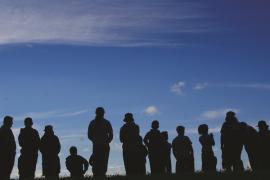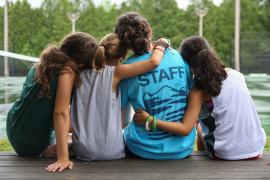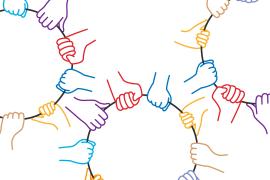When I first saw the now-famous TikTok explaining the term “quiet quitting” (Leppelin, 2022), it came across to me as laziness masquerading as inspiration.
As scenes of July 2022 NYC life flash by and soft piano music plays in the background, @zaidleppelin begins to half-explain/half-encourage a new work philosophy-turned-practice.
“You’re not outright quitting your job,” he said in a calm, even voice. “But you are quitting the idea of going above and beyond.” He finished his 17-second manifesto with a call to action: it’s time to reject hustle-culture by committing yourself only to baseline functioning at work — you are more than the labor extracted from you.
“Wow.” I said to myself, “That’s pretty cynical.”
The comments section – 490,000 deep – was a jumble of celebration and lamentation. Is this the little guy finally taking a stand against capitalism run amok, or is it just a catchy new term for slacking off? The internet couldn’t seem to agree. (It rarely does on anything these days.) But then I came across more and more responses that sounded less like laziness and more like something else.
“Does this ‘learning experience’ pay my bills or, better yet, pick up my kids from daycare?” said a fictional employee in a TikTok skit by @johnsfinancetips. His fictional boss had just asked him to come early and stay late, pitching it as “valuable learning experience.”
We're going to see articles in the future like, "Young people aren't volunteering for the Hunger Games anymore thanks to a terrifying new TikTok phenomenon called 'Wanting to Live.'" ranted @scottseiss as he rebuffed the latest term in the ongoing work debate: “rage applying.”
“Gen Z isn’t lazy,” I thought to myself, surprised at my own openness to the concept. “They’re burned out.”
How do I know? Because after 11 years of working in higher education, I burned out. Not the I’ve-had-that-meal-too-many-times-this-week kind of burnout, but the I-don’t-think-I-can-get-out-of-bed-today kind. Only after changing careers have I been able to look back and recognize the three defining features of burnout — exhaustion, cynicism, and reduced efficacy (WebMD) — clearly present in my daily experience at work. And as I browsed through the “quiet quitting” debate online, I could also clearly see all three burnout symptoms in many of the responses, all asking some form of the same question, “For what?” Because, at its core, burnout is about disengagement, not performance.
The concept of burnout isn’t new — it’s been around for nearly 50 years (King, 2016) — but its pervasiveness in modern society has reached a breaking point. The pressure for the medical community to address burnout became so great that in 2019 the World Health Organization included it for the first time in the 11th edition of its International Classification of Disease . A recent GALLUP study found that three out of four people experience some degree of burnout at work (Hemphill, 2022), and Asana’s Anatomy of Work study indicates that each generation is more susceptible to burnout than the one before it, with Gen Z passing Boomers, Gen X, and Millennials to lead the pack (2023). “Quiet quitting,” or the conscious choice to withhold discretionary energy from one’s work, is itself an acknowledgement that energy is not an infinite resource — not even for the young.
But fear not. Even as the data shows a growing burnout trend in emerging adults, it also indicates (albeit indirectly) that camps might just be the secret weapon we’ve been looking for to combat it. Many of the fixes for burnout — prioritizing self-care, shifting perspective, reducing exposure to stressors, and seeking connections (Valcour, 2016) — are already built into your facility and program, but that doesn’t mean steady engagement will happen all by itself. It’s time to add a Burnout and Energy Management module to your staff training program.
Building a training module on burnout for your staff doesn’t have to be complicated. It only needs three components: definitions, measurements, and responses. Let’s look at each one and consider different resources and methods to build engagement.
Definitions
Part of the problem with talking about burnout is how generic the term has become over time. We use it to explain why we stopped watching a show or eating at Taco Bell, a catch-all for boredom and fatigue. Fundamentally, burnout centers on the relationship between systems and energy. With this in mind, check out the following concepts and resources as options to help you build your own team training module that clearly defines what burnout is and how it works.
- Use the World Health Organization’s definition of burnout (who.int/news/item/28-05-2019-burn-out-an-occupational-phenomenon-international-classification-of-diseases) as a foundation to kick off a conversation about different kinds of exhaustion (physical, emotional, social, spiritual, etc.), the concept of depersonalization, and the consequences of reduced efficacy at camp.
- Use Paula Davis’s Beating Burnout at Work (2021) as a resource for an activity where teams brainstorm what the six drivers of burnout might look like and when/where they might appear during your camp season. Combine all the feedback to identify the greatest areas of risk and ask staff to contribute insights on how to compensate.
- Use Tom Rath and Donald Clifton’s How Full Is Your Bucket (2004) as a resource to introduce the concept of energy management. Take time for your team to consider the tasks, people, or situations that take energy from them as well as the tasks, people, or situations that add energy. Note cards and two buckets can provide a creative way for staff to write out and identify where their energy is coming from and where it’s going.
- Use Tom Wujec’s Draw Toast (2023) and Jennifer Moss’s The Burnout Epidemic (2021) as resources to introduce the concept of systems thinking and then use it to identify root causes of burnout as a response to imbalanced systems rather than blaming burnout on the individual as a failure to self-manage. Split into groups by camp subsystems (activities, counselors, food service, programming, etc.) and ask each group to look for process imbalances that could be problematic. Explore the differences between providing system-based solutions and generic complaining when approaching management.
Measurements
The second component of a training module that helps your team to manage their energy and avoid burnout is setting up measurement metrics and intervals. Chances are excellent that you already have several structured connections built into your daily camp schedule. These are opportunities for your team to assess their own energy levels as well as the different parts of the camp system they are engaged in. Consider the following strategies and resources as you build a training engagement that teaches your team to measure and report their energy in real time.
- Use Jacinta M. Jiménez’s The Burnout Fix (2021) as a resource to introduce the concept of energy audits. Agree as a team on the right interval (hourly, daily, weekly), method (forms, partners, groups, supervisors), and metrics (energy levels, wins, needs).
- Further use The Burnout Fix as a resource to introduce the concept of a “To Don’t” list. Ask each staff member to identify and write five personal energy-drainers they should avoid. Use software like Slido (slido.com) or Poll Everywhere (polleverywhere.com) to build a word cloud that quickly visualizes team energy-drainers.
Responses
To some extent, burnout is inevitable at camp, as many of your staff are still learning how to manage their own energy levels while the daily demands of a camp program require an enormous amount of energy. The third component of an effective staff training module about burnout focuses on how to respond once burnout has been identified. Here are a few resources and ideas for you to think about as you build engagement.
- Use Beating Burnout at Work (Davis, 2021) as a resource to develop a reporting network that works for your team. Keep in mind that it doesn’t need to be based in the leadership hierarchy of the rest of your program. Information just needs to land in a place where those who can make process changes can see and respond to it. This could be related to the energy audit process developed earlier, or it could be a separate pathway. Consider when/how to integrate modern technology into your reporting process so you can offer an “energy 9-1-1” safety net.
- Use Alex Soojung-Kim Pang’s Rest: Why You Get More Done When You Work Less (2016) as a resource to introduce the concept of “deep play.” Ask returning staff members to generate a compressive list of their favorite places and activities, both on- and off-site. Set up a central space, either online or somewhere on site, where team members can report and showcase new places and experiences for others to try during their time off. Identify times and methods for camp staff to enjoy the activities your facility offers for themselves.
Discretionary energy is the lifeblood of camp. It’s what identifies and solves small problems before they become large. It makes rainy-day activities a cherished memory instead of a boring grind. And it smoothly hides a pee-soaked sleeping bag from the rest of the cabin to spare a nervous camper the humiliation.
Yes, research shows that exhaustion, discontent, and competency gaps are growing problems in today’s workforce and, to be clear, every generation has its share of slackers. But the research also shows that consistent empathy, regular communication, and strong community connections are the most potent and effective responses to disengagement and burnout. That should be encouraging to camps, because it means they have the main burnout-combating tools already in hand. Burnout is a problem that won’t get solved overnight, but to ignore it risks having the camp experience drain team members rather than build them up. Adding some targeted resources and thoughtful engagements to your staff training season might mean the difference between a group that quietly quits and one that stays loudly engaged.
Photos courtesy of Elbow Land Day Camp, Warrington, PA; Camp Chewonki, Wiscasset, ME; Camp Center Stage, Livermore, ME.
References
Asana. (2023). Anatomy of work global index. asana.com/resources/anatomy-of-work
Davis, P. (2021). Beating burnout at work: Why teams hold the secret to well-being and resilience. Philadelphia, PA: Wharton School Press.
Hemphill, E. B. (2022, December 6). Uncomfortable (but necessary) conversations about burnout. Gallup. gallup.com/workplace/406232/uncomfortable-necessary-conversations-burnout.aspx
Jiménez, J. M. (2021, March 17). The burnout fix: Overcome overwhelm, beat busy, and sustain success in the new world of work. New York, NY: McGraw-Hill Education.
King, N. (2016, December 8). When a psychologist succumbed to stress, he coined the term ‘burnout.’ NPR. npr.org/2016/12/08/504864961/when-a-psychologist-succumbed-to-stress-he-coined-the-term-burnout
Leppelin, Z. (2022, July 25). On quiet quitting. tiktok.com/@zaidleppelin/video/7124414185282391342?lang=en
Moss, J. (2021, September 28). The burnout epidemic: The rise of chronic stress and how we can fix it. Boston, MA: Harvard Business Review Press.
Pang, A. S. (2016, December 6). Rest: Why you get more done when you work less. New York, NY: Basic Books.
Rath, T. & Clifton, D. O. (2004). How full is your bucket? New York, NY: Gallup Press.
Valcour, M. (2016, November). Beating burnout. Harvard Business Review. hbr.org/2016/11/beating-burnout
WebMD. (2022, December 18). Burnout: Symptoms and signs. webmd.com/mental-health/burnout-symptoms-signs
World Health Organization. (2019, May 28). Burn-out an “occupational phenomenon”: International Classification of Diseases. who.int/news/item/28-05-2019-burn-out-an-occupational-phenomenon-international-classification-of-diseases
Wujec, T. (2023). Draw how to make toast. tomwujec.com/draw-toast
Donnie Keele III is a communicator and certified life coach focused on helping others discover and share what makes them unique and gives them purpose. Holding degrees in mass communication and campus chaplaincy and shaped by 15+ years of experience split between summer camp administration and university student affairs, he now creates digital media and learning engagements at UltraCamp in Niles, Michigan. His current focus is helping camp professionals make sense of complex and shifting demands so they can continue growing as exceptional leaders who provide transformational experiences for campers and staff alike.





